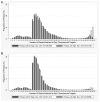Discovery of cross-reactive probes and polymorphic CpGs in the Illumina Infinium HumanMethylation450 microarray
- PMID: 23314698
- PMCID: PMC3592906
- DOI: 10.4161/epi.23470
Discovery of cross-reactive probes and polymorphic CpGs in the Illumina Infinium HumanMethylation450 microarray
Abstract
DNA methylation, an important type of epigenetic modification in humans, participates in crucial cellular processes, such as embryonic development, X-inactivation, genomic imprinting and chromosome stability. Several platforms have been developed to study genome-wide DNA methylation. Many investigators in the field have chosen the Illumina Infinium HumanMethylation microarray for its ability to reliably assess DNA methylation following sodium bisulfite conversion. Here, we analyzed methylation profiles of 489 adult males and 357 adult females generated by the Infinium HumanMethylation450 microarray. Among the autosomal CpG sites that displayed significant methylation differences between the two sexes, we observed a significant enrichment of cross-reactive probes co-hybridizing to the sex chromosomes with more than 94% sequence identity. This could lead investigators to mistakenly infer the existence of significant autosomal sex-associated methylation. Using sequence identity cutoffs derived from the sex methylation analysis, we concluded that 6% of the array probes can potentially generate spurious signals because of co-hybridization to alternate genomic sequences highly homologous to the intended targets. Additionally, we discovered probes targeting polymorphic CpGs that overlapped SNPs. The methylation levels detected by these probes are simply the reflection of underlying genetic polymorphisms but could be misinterpreted as true signals. The existence of probes that are cross-reactive or of target polymorphic CpGs in the Illumina HumanMethylation microarrays can confound data obtained from such microarrays. Therefore, investigators should exercise caution when significant biological associations are found using these array platforms. A list of all cross-reactive probes and polymorphic CpGs identified by us are annotated in this paper.
Keywords: CpGs; DNA methylation; Illumina microarray; SNPs; cross-reactive probe; oligonucleotide probe; polymorphic CpG.
Figures



References
Publication types
MeSH terms
Substances
LinkOut - more resources
Full Text Sources
Other Literature Sources
